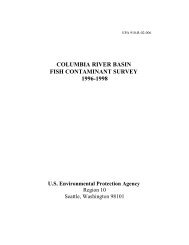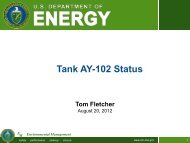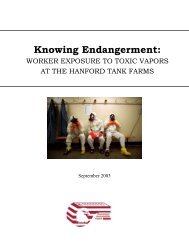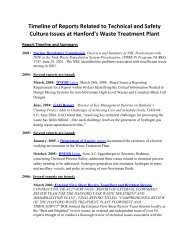Reducing the Risks of High-Level Radioactive Wastes at Hanford
Reducing the Risks of High-Level Radioactive Wastes at Hanford
Reducing the Risks of High-Level Radioactive Wastes at Hanford
Create successful ePaper yourself
Turn your PDF publications into a flip-book with our unique Google optimized e-Paper software.
46 Alvarez<br />
nuclear accident scenarios, or disposal decisions. Of particular concern is <strong>the</strong><br />
high vulnerability to environmental contaminants <strong>of</strong> thousands <strong>of</strong> tribal people<br />
living near <strong>Hanford</strong>.<br />
This was underscored in 2002 by <strong>the</strong> U.S. Environmental Protection Agency<br />
which found th<strong>at</strong> fish near <strong>the</strong> site have <strong>the</strong> highest contaminant concentr<strong>at</strong>ions<br />
in <strong>the</strong> Main Stem Columbia River Basin. EPA estim<strong>at</strong>ed th<strong>at</strong> lifetime<br />
f<strong>at</strong>al cancer risks from fish consumption to tribal people are as high as 1 in<br />
50. Usually, EPA takes regul<strong>at</strong>ory action when contaminant risks exceed 1 in<br />
10,000 to 1 in 1,000,000. Around <strong>the</strong> time <strong>the</strong> EPA study was released, DOE set<br />
a radi<strong>at</strong>ion standard to protect fish from <strong>Hanford</strong>’s radionuclides th<strong>at</strong> would<br />
result in doses to tribal people several hundred times gre<strong>at</strong>er than allowed by<br />
<strong>the</strong> Environmental Protection Agency.<br />
PROJECT MANAGEMENT ISSUES<br />
Since <strong>the</strong> <strong>Hanford</strong> waste tre<strong>at</strong>ment plant is a first-<strong>of</strong>-a-kind endeavor, safety<br />
and operability <strong>of</strong> this project is highly dependent on knowledge <strong>of</strong> physical<br />
and chemical properties <strong>of</strong> <strong>the</strong> wastes. However, <strong>the</strong> N<strong>at</strong>ional Research Council<br />
finds th<strong>at</strong> <strong>Hanford</strong> waste d<strong>at</strong>a “is <strong>of</strong> little value in designing chemical remedi<strong>at</strong>ion<br />
processing.” In light <strong>of</strong> <strong>the</strong>se uncertainties, worldwide high-level waste<br />
vitrific<strong>at</strong>ion experience encourages extraordinary caution be exercised <strong>at</strong> <strong>Hanford</strong>.<br />
But DOE has raised <strong>the</strong> stakes by deciding to forego a pilot plant using<br />
actual <strong>Hanford</strong> wastes and to concurrently design and construct a full-scale<br />
facility.<br />
Over <strong>the</strong> past 20 years, less than five percent <strong>of</strong> all defense high-level<br />
wastes have been processed, while incurring soaring costs, projected to exceed<br />
$100 billion. DOE’s inability to manage <strong>the</strong>se projects is a major factor behind<br />
<strong>the</strong>se difficulties. For instance, a 20-year failure to pretre<strong>at</strong> soluble wastes <strong>at</strong><br />
<strong>the</strong> Savannah River Site has resulted in a loss <strong>of</strong> $500 million, with projected<br />
costs <strong>of</strong> $1.8 billion. The U.S. General Accounting Office <strong>at</strong>tributes this problem<br />
to a management culture based on an “undocumented policy <strong>of</strong> blind faith in<br />
its contractors’ performance.” Growing Congressional concern has resulted in<br />
recent reports by <strong>the</strong> N<strong>at</strong>ional Research Council, which found:<br />
<br />
<br />
<br />
<br />
Environmental projects suffer from major delays and are about 50 percent<br />
more expensive than comparable federal and priv<strong>at</strong>e-sector projects;<br />
Up-front project planning is inadequ<strong>at</strong>e;<br />
There is no consistent system for evalu<strong>at</strong>ing project risks; and<br />
DOE is not in control <strong>of</strong> many <strong>of</strong> its projects.<br />
Capital costs for <strong>the</strong> <strong>Hanford</strong> vitrific<strong>at</strong>ion plant are a rel<strong>at</strong>ively small portion<br />
<strong>of</strong> <strong>the</strong> total life-cycle costs for <strong>the</strong> project. The failure to address critical







